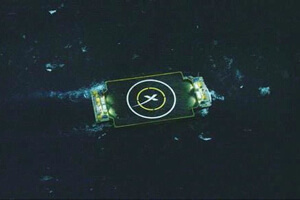A week ago, in the open ocean off the Florida coast, the first stage of a SpaceX Falcon 9 rocket nearly made history. SpaceX is attempting to recover, refurbish, and reuse its rockets to radically slash launch costs.
While the rocket’s second stage and Dragon capsule continued to a successful rendezvous with the ISS, the first stage plummeted through the atmosphere, fired its engines to slow itself and deployed fins to precisely guide its descent.

In similar attempts last year, two rockets executed a soft landing over the ocean before toppling over and being lost to the waves.
This time, however, the rocket had a floating landing pad waiting for it.
Whereas the previous attempts proved the rockets could come in soft, they weren’t precise—SpaceX targeted a landing accuracy of 10 kilometers. For the latest attempt, landing on what amounted to a postage stamp, the required accuracy was 10 meters.
SpaceX founder and CEO, Elon Musk, put the likelihood of success at 50%. And in one sense he was on the money. The attempt was half successful. On one hand, the rocket hit its target—no small feat. On the other hand, it struck a glancing blow, exploded, and ricocheted into the ocean in pieces. Obviously, not the outcome they were looking for.
The good news is SpaceX engineers think they discovered the problem, and it’s a pretty easy fix. The rocket’s four directional fins ran out of hydraulic fluid causing them to malfunction. The engines couldn’t compensate, and though the rocket still hit the target, it came in hard at an angle, exploded, and was thrust overboard. (See video of the crash below.)
Musk tweeted, “Close, but no cigar this time.” Later in the week he noted they’ll add 50% more hydraulic fluid for the next launch, scheduled for February 9 (or thereabouts—the last launch was rescheduled several times).
If successful, it’ll be a big day for space exploration.
SpaceX has already reduced launch costs significantly. If they can rapidly reuse the first stage, they may reduce them even more. Just how much depends mostly on the cost to refurbish the rockets and their lifetime.
But all that’s looking into the future. For a moment we thought we’d look back. Here are our favorite SpaceX videos showing the program’s progression from first tests to last week’s partial success. (Excited for the next attempt!)
First Hop: Early trials in 2012 used the first stage of a Falcon 9 rocket with one Merlin engine (instead of the Falcon 9’s nine). The test rocket was dubbed Grasshopper. See the program’s humble beginnings with Grasshopper’s first 6-foot hop.
Precision Flight: During the next year of increasingly higher flights (up to 744 meters), Grasshopper here shows precision, sensor-guided steering by flying 250 meters up and 100 meters to the side, returning to the pad and landing on a dime.
Falcon 9R Spreads Wings: After Grasshopper, SpaceX tested a full Falcon 9 first stage equipped with landing gear and fins in “X-wing” configuration. The fins, which malfunctioned in last week’s test, help aim the rocket with even greater precision.
A Soft Ocean Landing: Last summer, SpaceX moved beyond the test range with two live attempts at soft landing a first stage on the Atlantic Ocean. After the first attempt was largely obscured by stormy weather (though deemed successful), a chase plane captured a clear view of a controlled, vertical landing of the rocket’s first stage. SpaceX says, “Stabilizing the Falcon 9 first stage for reentry is like trying to balance a rubber broomstick on your hand in the middle of a wind storm.”
“Close, But No Cigar This Time.” In last week’s first attempt to actually recover the rocket intact, the hypersonic fins ran out of hydraulic fluid, and the rocket was unable to make a soft landing on the SpaceX ocean platform. Here you can see it come in at an angle, hit hard, and commence, in Musk’s words, a full RUD (rapid, unscheduled disassembly). They’ll add more hydraulic fluid for the next attempt in a few weeks. And Musk said, “At least it should explode for a different reason.”
Image Credit: SpaceX; Elon Musk/Twitter



